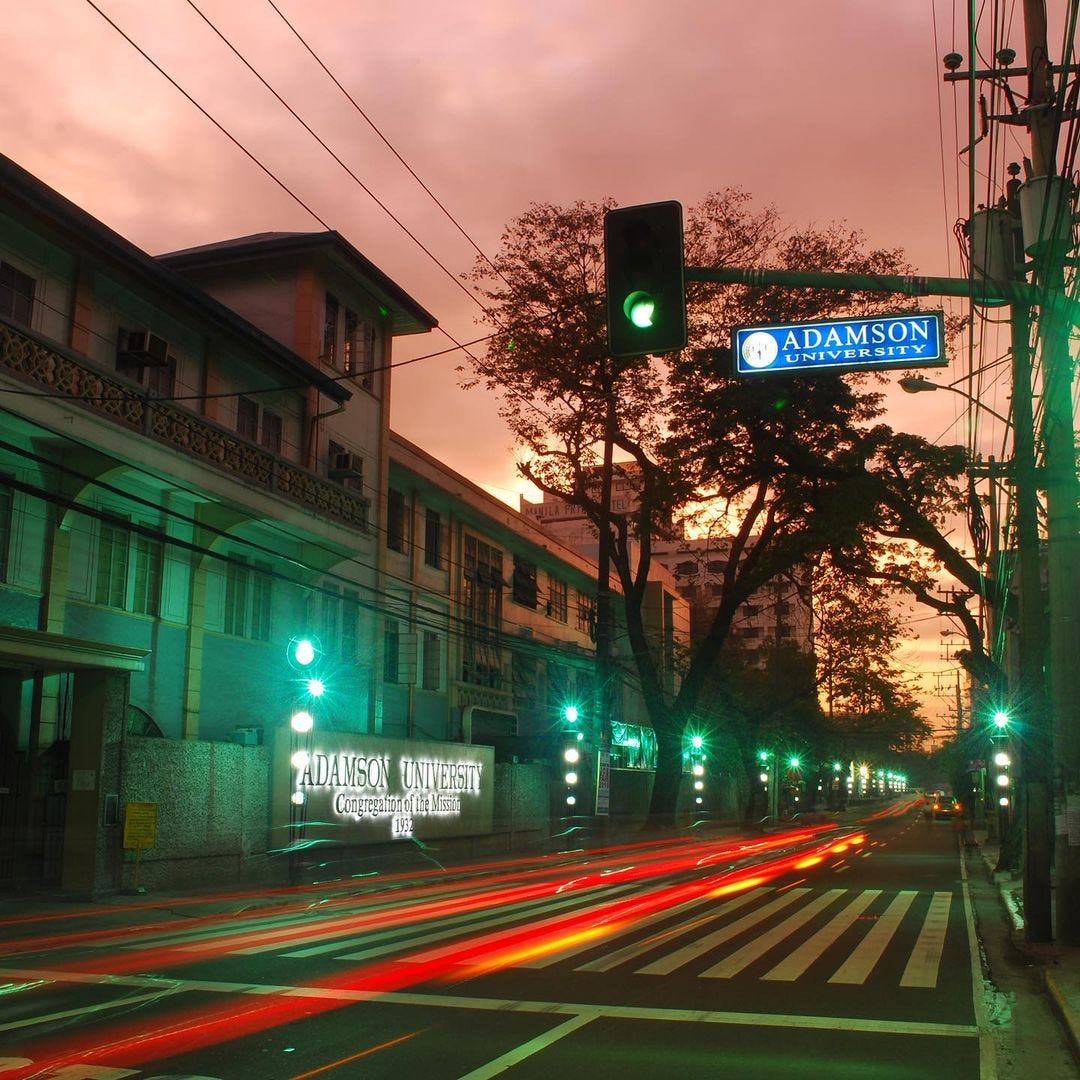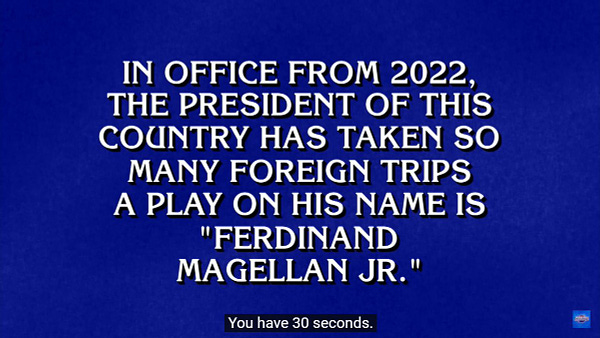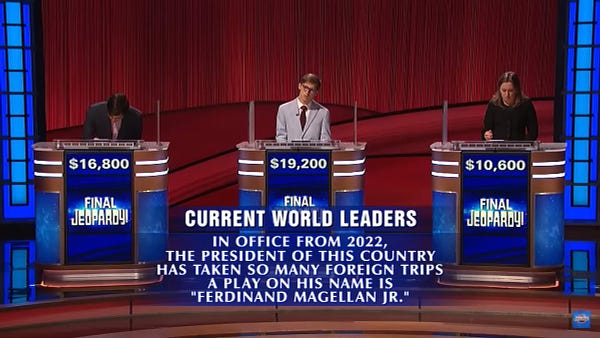Hello everyone!
Here’s a little round-up of two key stories in the Philippines in the last week/month. I’m also very intrigued by the impending strikes over a change to jeepney policy and the ongoing battle between cyclists and motorists. Both of these stories are still developing and I’m looking forward to bringing updates next week.
Don’t forget to join us on the premium list if you haven’t yet! I will always keep subscriptions free for Asean and Timorese nationals under 30, or readers from Myanmar of any age, so if you qualify let me know and I can activate that option for you.
See you next week!
Erin Cook
Hazing tragedy sparks investigation, introspection

The Adamson University community are in shock and the Department of Justice is moving quickly on the alleged hazing death of 24-year-old student John Matthew Salilig. Salilig’s body was found buried in a shallow grave in Imus City, Cavite on Tuesday — more than a week after he was reported missing. An autopsy conducted later that day found his cause of death to be “severe blunt force trauma to the lower extremities,” and his remains had several hematomas on his thighs and chest.
Six Tau Gamma Phi fraternity members of the university will face charges under the Philippines’ anti-hazing law. Salilig’s brother and another alleged victim of the frat’s hazing filed the complaint, alleging they had killed the young man during rites on Feb. 18. Biñan police chief Lt. Col. Virgilio Jopia said Salilig had vomited around two hours after the hazing began at 1 pm but the members did not stop their assault until 5 pm. Gregorio Cruz, the father of the owner of an SUV used to transport Salilig to Metro Manila before he died in the car, has been charged with obstruction of justice.
The police boss alleges the group declined to take Salilig to hospital after he’d died, instead opting to ditch his remains in a vacant lot. “The reason why the victim was found naked was because their initial plan was to burn the body. Maybe they became hesitant because burning might create fire. And, of course, they would be noticed,” Jopia said. Ten others are wanted in the case.
Students from Adamson University have come together to demand the administration properly and effectively investigate the tragedy. “As a collective catalyst for change, security, and unity, we stand in solidarity with the family of the bereaved. We vehemently urge the University Administration to take bolder steps towards the search for truth. In justice for Matt’s cruel demise, we strongly urge the people involved to speak nothing but the truth about the incident. To speak ambiguously of his case only protects the offenders behind this heinous crime,” student government and campus organisations said in a statement Wednesday, as per Coconuts.
The National Bureau of Investigation (NBI) and Commission on Human Rights (CHR) will both investigate in separate cases. Elsewhere, the response has been extraordinarily serious. “The PNP gives stern warning to anyone, regardless of position or status in life, that the attempt to intervene and meddle in the conduct of investigation and prosecution of the said case will not be tolerated,” the Philippines National Police cautioned in a statement.
Hazing has a long, horrible history in the Philippines. There is a large page on Wikipedia collating deaths beginning in 1954 and ending with Salilig last month. In 2022 alone, three young men were killed. Tau Gamma Phi’s name features frequently.
In a statement, Senate Majority Leader Joel Villanueva, himself a member of the Tau Gamma Phi frat, demanded the anti-hazing law be overhauled. “In the midst of this new case of hazing, we need to be more proactive and revisit the law to ensure that it is being implemented properly,” he said, as per PhilStar.
Marcos has hit the skies running. Why?
I have some thoughts on President Bongbong Marcos. A lot of thoughts — please indulge me!



While I’ve never heard the Magellan Jr gag, it’s plainly obvious Bongbong Marcos Jr has been hitting the road. Predecessor Rodrigo Duterte would occasionally have to show signs of life while holed up in Davao City, opting to neither travel as a world leader nor spend much time in the capital. Maybe that’s skewing optics a little.
In my own country Australia, our new prime minister wore a bit of criticism for travelling internationally a lot after he was elected. It was at the same time as big multilateral meetings, but there was also a degree of re-engaging with the world after a predecessor so fixated on the US and the UK it felt like the 50s. The stakes are different for Marcos — his country, no matter who leads it, is stuck between history and geography in a way few others are currently — but there is some similarity.
Is Marcos Jr re-establishing the Philippines, getting ahead of the geopolitical dramas that seem to be just around the corner? Some opposition figures and critics worry that his push for engagement could endanger the country further if conflict were to erupt nearby. And, no doubt for some, all the travel does also bring to mind the extravagant trips taken by the family in its earlier Malacañang stint.
In February, Marcos Jr swung by Japan for his first visit as president. It came just days after the announcement of deeper cooperation with the US military and a Beijing trip to meet Chinese President Xi Jinping. Neil Imperial, the Philippines assistant secretary for Asian and Pacific Affairs, told media Marcos Jr. was looking to “facilitate closer defence, security, political, economic and people-to-people ties,” as per Al Jazeera. The piece also quotes a Japanese official telling Reuters that more US engagement means Japan ought to step it up too.
Marcos Jr let Australia come to him this week with Australian Defence Minister Richard Marles meeting counterpart Carlito Galvez in Manila. “We did talk today about the possibility of exploring joint patrols and we will continue that work and we hope that comes to fruition soon,” Marles said, as reported by Reuters.
And, despite previous reservations, Marcos. Jr is now all in on the RCEP — the last country bar Myanmar to sign on. “With the country's participation [in] RCEP, the Philippines has now further strengthened its position as an ideal investment hub in the region as we expand market access, facilitate trade, and align our rules and procedures with participating economies,” National Economic and Development Authority Secretary Arsenio Balisacan said, as per Nikkei Asia.
It’s with that in mind that this report from Sui-Lee Wee and Camille Elemia at the New York Times has continued to rattle around in my brain. It goes deep on what the US is seeking in its relationship with the Philippines and the lay of the defence land as it stands now.
The power balance between the former colony and former overlord has shifted dramatically since the US military was booted out in the early 1990s. The Philippines is now appreciated as a more equal partner to the superpower. But the power imbalance within the Philippines remains stark: “China is not our enemy. The people of Cagayan will get caught in the middle … Why should we fight their battles?” Cagayan Governor Manuel Mamba told the NYT. He had not been informed of plans for the military site and worries it could make the area a target for a nuclear attack.
Is Marcos Jr. being savvy, or is he making “the choice” between China and the US? Opinions vary. My personal views oscillate wildly (and are no doubt informed by my own views on the US in Asia-Pacific and what Marcos personally wants). This from DW takes a look at the range, with the consensus seeming to be US for defence, China for business. Which, I suppose, is not all that different from just about every country in the region. So why is this so captivating?
Reading list
Drugs, jacuzzis and a horse: the anarchic Philippines prison where anything can be bought - The Guardian
To prevent disorder from breaking out, prison officers and inmates develop their own structures to manage day-to-day life. An inmate hierarchy exists across the prison, with prisoners taking on various roles and positions.
Basic functions – even securing the keys – are delegated to prisoners.
“They are the ones headcounting the inmates, they are the ones maintaining the cleanliness of the cell,” says Narag, who spent more than six years in prison before a court found he had been wrongly accused. He has since become an expert on prison reform.
Inmates are also allowed to receive resources from the outside, such as medicine, food or clothes, and cash of about US$40 a time per visitor, meaning there is also a layer of commerce throughout the jail, says Narag.
But 37 years later, as Filipinos march through the streets to commemorate that anniversary, Ms Taguiwalo says her worst fears have been realised. Marcos Sr's son, "Bongbong" Marcos, has become president and Mr Enrile - once on the side of the People's Power revolt - is now a key adviser to the new leader.
With the deft use of social media, Marcos Jr has recast his father's reign as a golden age for peace and infrastructure, dismissing the record of human rights abuses and corruption as an unfair vilification of the family.
"I feel angry at the injustice of it all," says Ms Taguiwalo, now 73. "It makes me really sad."
She and Mr Enrile are both survivors of the Philippines' People Power revolt - but they tell very different stories of the movement's legacy.
In the Philippines, terrible crimes against children are often facilitated by their mothers - ABC (not a fan of this headline, but a well-reported piece on a disturbing topic)
In a pokey office above the dormitory for new recruits at the Philippines National Police, an international task force is helping fight the Philippines' "war" on online child exploitation.
The Philippine Internet Crimes Against Children Center is made up of experts and police from the Philippines, Australia, the UK, the Netherlands and the US.
Its mission is to help local authorities hunt down the facilitators and to locate abused children, often by gathering leads and information from foreign police agencies.
If Australian police arrest an offender or uncover child abuse material involving Filipino children, the task force picks up the trail in the Philippines.

